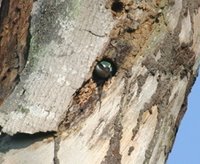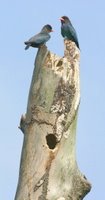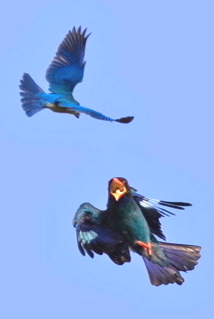Life around a rotting tree trunk 3: The coming of the Dollarbirds
 The pair of Collared Kingfishers (Todiramphus chloris) nesting in a cavity found at the central point of a rotting tree trunk in a small piece of secondary growth at Eng Neo had no problems of accessibility to their nest most of March 2006. By early April a pair of Dollarbirds (Eurystomus orientalis) took over the nest at the top cavity from the pair of Long-tailed Parakeets (Psittacula longicauda). The nesting parakeets gave the kingfishers no problem. Not so the Dollarbirds.
The pair of Collared Kingfishers (Todiramphus chloris) nesting in a cavity found at the central point of a rotting tree trunk in a small piece of secondary growth at Eng Neo had no problems of accessibility to their nest most of March 2006. By early April a pair of Dollarbirds (Eurystomus orientalis) took over the nest at the top cavity from the pair of Long-tailed Parakeets (Psittacula longicauda). The nesting parakeets gave the kingfishers no problem. Not so the Dollarbirds. The pair of Dollarbirds regularly patrolled the area around the tree trunk or simply perched at the top, defending their territory jealously. Whenever a kingfisher approached its nest at the central cavity, one or the other of the Dollarbirds would fly out to meet it halfway. There would always be a confrontation and the kingfisher would veer off, not able to enter the nest. Only when the Dollarbirds were absent could the kingfishers fly into their nest to feed their young.
The pair of Dollarbirds regularly patrolled the area around the tree trunk or simply perched at the top, defending their territory jealously. Whenever a kingfisher approached its nest at the central cavity, one or the other of the Dollarbirds would fly out to meet it halfway. There would always be a confrontation and the kingfisher would veer off, not able to enter the nest. Only when the Dollarbirds were absent could the kingfishers fly into their nest to feed their young.Allan Teo, an avid photographer, captured the dramatic moments when both birds confronted each other. His two crucial images show first, the Dollarbird flying off its perch when the kingfisher flew towards its nest. At about 2.5 metres away, the former lunged an attack.


In his very own words: “The Dollarbird defended its ground aggressively. Not to be put off, the Collared Kingfisher also stood it ground. No contact was made between the birds as the 'fighting' took place. The kingfisher veered off the perimeter defence of the Dollarbird and both went apart peacefully after that. Note that the Dollarbird can 'freeze' in midair whilst the kingfisher cannot.
”The action took place in split seconds and the camera could capture the action. Photography provides another valuable insight into intelligent animal behaviour.”
I totally agree. Photography has an important role to play in the study of bird behaviour. That is why more and more birders are taking photography, including digiscoping and videoscoping.
Input by Allan Teo, images by YC (top two) and Allan (bottom two of Dollarbird attacking kingfisher).
Our bird specialist, R. Subaraj, has this to say: "This is intra-species bird behaviour at its best! The agression shown by nesting birds is quite interesting to observe. Yet, the general lack of nesting holes, especially for species not able to excavate cavities for themselves in living wood, can make for lots of fighting for nesting space. Likewise, woodpeckers and barbets, who are able to excavate their own nesting holes, are often displaced from them by other hole-nesters.
"The situation is further complicated by the active removal of dead branches and trunks, for fear that they would fall down and cause damage to property. The loss of rural areas in recent times, particularly coconut groves, has also removed many potential nesting sites for such birds. The "topless" coconut trunks are favourite nesting sites for Dollarbirds, parakeets and other hole-nesting species."



2 Comments:
Are we able to create artificial nesting holes to cater for the birds since tree holes are always in such short supply?
The Hornbill Project that is now going on in Singapore is testing the use of artificial nesting holes. I am sure we can provide such holes for other species of birds as well.
Post a Comment
<< Home